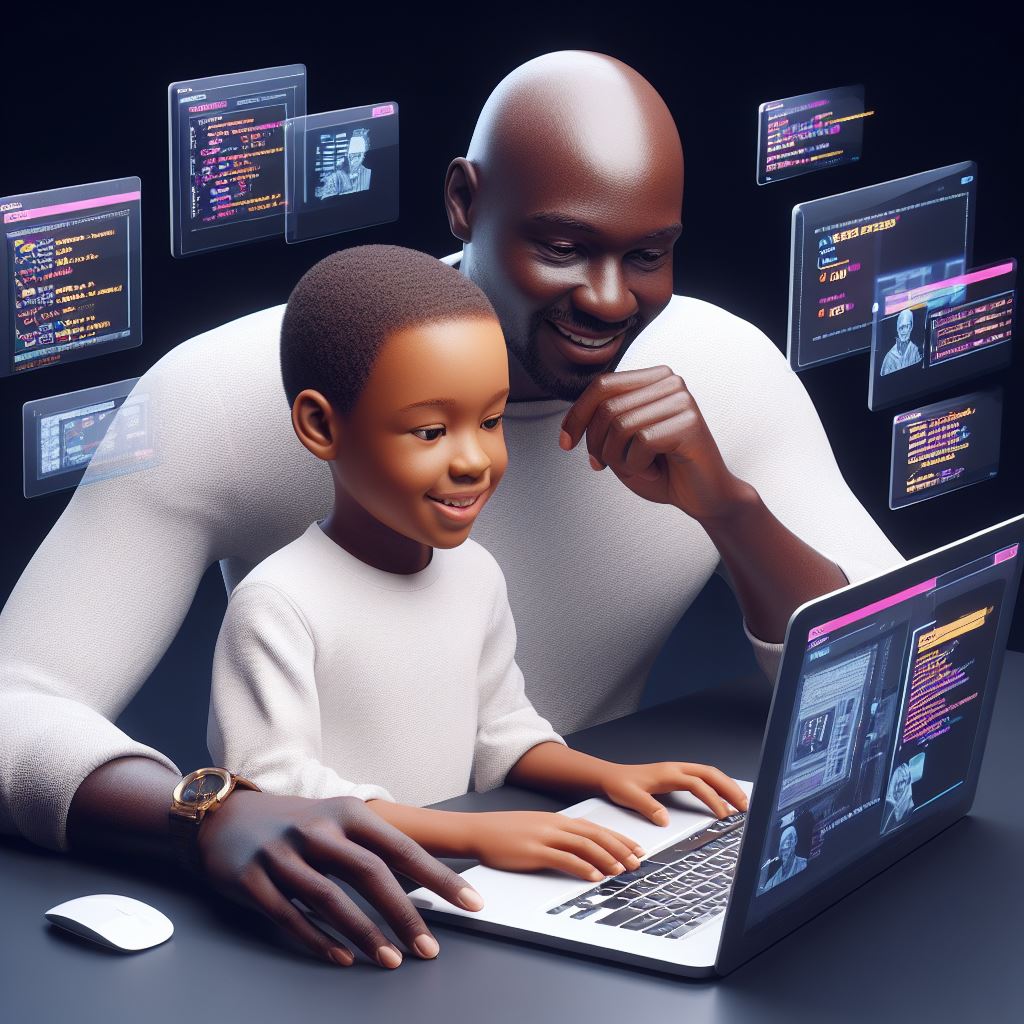Introduction
Welcome to the introduction of the blog post on “Python for Kids: A Starter Guide for Nigerian Parents”
Python is a popular programming language known for its simplicity and readability. Introducing coding to kids at an early age is crucial for their cognitive development.
Coding helps kids think logically, and solve problems and boosts their creativity and critical thinking skills.
Python, being beginner-friendly, is an ideal language to start with for young learners.
Nigerian parents should consider teaching Python to their children to equip them with essential future skills. Python allows kids to create games, animations, and websites, making learning fun and engaging.
Through Python, kids can develop a strong foundation in programming, preparing them for advanced languages.
Learning Python empowers kids to become creators rather than just consumers of technology. With Python, kids can bring their imaginations to life and express themselves creatively.
In short, introducing Python programming to Nigerian kids can be a valuable investment in their future.
Teaching Python to Kids: Benefits and Importance
Are you a Nigerian parent contemplating which programming language to introduce to your kids? Look no further than Python.
Python is an excellent language to start with, and it offers numerous benefits that can help children develop valuable skills.
Here are some reasons why teaching Python to kids is a great idea:
Enhances problem-solving and critical-thinking skills
- Python requires kids to tackle problems and come up with effective solutions.
- Through coding, children learn to break down complex problems into smaller, manageable tasks.
- They gain critical thinking skills by analyzing different approaches to programming challenges.
- Python encourages kids to think logically and develop step-by-step problem-solving strategies.
Boosts creativity and encourages logical thinking:
- Python allows kids to express their creativity by creating interactive games, stories, and artwork.
- They can experiment with different concepts and develop their unique projects.
- Programming in Python involves logical thinking, as kids need to understand the cause-effect relationships in their code.
- They learn to predict and analyze outcomes, developing their logical reasoning skills.
Prepares kids for future careers in technology:
- Python is one of the most widely used programming languages in various industries.
- Kids who learn Python at an early age gain a valuable head start in the field of technology.
- Python skills are highly sought-after, and proficiency in the language opens doors to exciting career opportunities.
- Technology is advancing rapidly, and Python proficiency prepares kids for the changing job market.
- Learning Python also provides a solid foundation for learning other programming languages in the future.
In addition to these benefits, teaching Python to kids has become easier than ever. There are many resources available specifically designed for young learners.
These resources include interactive games, visual programming tools, and online tutorials tailored to children’s learning needs.
Parents can also encourage their kids to participate in programming clubs and competitions, where they can showcase their skills and engage with like-minded peers.
Collaborating on coding projects with other young programmers helps foster teamwork and enhances problem-solving abilities.
Unlock Your Unique Tech Path
Get expert tech consulting tailored just for you. Receive personalized advice and solutions within 1-3 business days.
Get StartedMoreover, Python’s simplicity and user-friendly syntax make it an ideal choice for kids.
Its readability and straightforwardness allow children to focus on learning programming concepts rather than getting lost in complicated syntax, which can be discouraging for beginners.
Teaching Python to kids empowers Nigerian parents, equipping their children with valuable technical skills.
Additionally, it enables them to think critically, solve problems creatively, and adapt to a rapidly evolving technological landscape.
Overall, Python offers a fun and engaging way for kids to enter the world of programming. So, why wait?
Start introducing Python to your kids today and watch them grow into confident problem solvers and future tech leaders.

How to get started with Python for kids
Getting started with Python for kids can be an exciting and educational journey.
Python is a popular programming language that is beginner-friendly, making it a great choice for kids who want to learn how to code.
In this blog section, we will explore the steps to get started with Python for kids, including choosing the right resources, setting up the development environment, and introducing basic programming concepts.
Choosing the Right Resources and Materials
When introducing your kids to Python, it’s important to choose the right resources and materials.
There are many online resources, books, and tutorials available specifically designed for teaching kids Python.
Look for resources that have interactive exercises, colourful illustrations, and a fun approach to learning. This will help engage your kids and make the learning process enjoyable.
Some popular Python books for kids include:
- “Python for Kids: A Playful Introduction to Programming” by Jason R. Briggs
- “Hello World!: Computer Programming for Kids and Other Beginners” by Warren Sande and Carter Sande.
Setting up the Development Environment
Before your kids can start coding in Python, you need to set up the development environment.
Unlock Premium Source Code for Your Projects!
Accelerate your development with our expert-crafted, reusable source code. Perfect for e-commerce, blogs, and portfolios. Study, modify, and build like a pro. Exclusive to Nigeria Coding Academy!
Get CodeThe development environment includes a text editor or an integrated development environment (IDE) where your kids will write and run their Python code.
For beginners, a simple text editor like Sublime Text or Notepad++ can suffice. However, if you want a more feature-rich IDE, consider using Python-specific IDEs like IDLE, PyCharm, or Thonny.
These IDEs provide additional features like code suggestions, debugging tools, and a user-friendly interface for kids.
Introducing Basic Programming Concepts
Once the development environment is set up, it’s time to introduce basic programming concepts to your kids.
Start by explaining what variables are and how they can be used to store data. Show them examples of how variables can be used to perform calculations or display messages.
Next, introduce loops, which help automate repetitive tasks.
Explain the concept of a loop and demonstrate how it can be used to iterate over a set of instructions multiple times. You can use fun examples like counting from 1 to 10 or printing a pattern using loops.
Finally, introduce functions, which are reusable blocks of code.
Explain how functions can be defined and called to perform specific tasks. Encourage your kids to create their own functions and use them in their programs.
By introducing these basic programming concepts, your kids will gain a solid foundation in Python and be able to start coding their own programs.
In summary, getting started with Python for kids is an exciting and educational journey.
By choosing the right resources, setting up the development environment, and introducing basic programming concepts, you can empower your kids to learn and explore the world of coding with Python.
Read: Summer Coding Programs for Kids in Nigeria: A Guide
Fun projects and activities to engage kids in Python
In today’s digital age, it is essential for children to learn coding from an early age. Python, being a beginner-friendly language, is an excellent choice to introduce kids to the world of programming.
In this section, we will explore various fun projects and activities that can engage kids in learning Python.
1. Fun projects and activities to engage kids in Python
Python offers a wide range of creative and exciting projects for kids. They can start with simple tasks like creating a program to draw shapes or generating patterns using loops and conditionals.
2. Creating simple games or simulations
Kids love playing games, and what’s better than creating their own?
Python allows children to develop simple yet engaging games like Tic-Tac-Toe or Hangman. It teaches them the importance of logic and problem-solving.
3. Developing interactive stories or chatbots
Python enables children to create interactive stories by combining text and graphics.
They can also build chatbots that simulate conversations with users. These projects enhance their creativity and communication skills.
4. Exploring data visualization and graphing
Python libraries like Matplotlib or Turtle can be used to visualize data and create graphs.
Kids can analyze data sets and represent them in a visually appealing manner. This helps them understand the importance of data analysis and presentation.
5. Collaborating on coding projects
Encourage kids to collaborate with their peers or join coding clubs to work on coding projects together.
Collaboration fosters teamwork, problem-solving, and communication skills in a fun and interactive environment.
6. Participating in coding competitions
Organize coding competitions for kids where they can showcase their Python skills.
It not only boosts their confidence but also exposes them to real-world coding challenges and improves their problem-solving abilities.
7. Incorporating coding into everyday activities
Find unique ways to incorporate coding into everyday activities.
For example, kids can write a Python program to control a robot or automate simple tasks at home. This makes coding more practical and relevant to their daily lives.
8. Attending coding workshops or camps
Encourage kids to attend coding workshops or camps focused on Python.
These programs provide structured learning, hands-on activities, and expert guidance, making the learning experience more immersive and engaging.
9. Providing guidance and support
As parents, it is crucial to provide guidance and support throughout the coding journey.
Encourage kids to ask questions, seek help when needed, and celebrate their achievements. Your involvement boosts their confidence and motivation.
10. Showcasing their projects
Encourage kids to showcase their Python projects to friends, family, or even at school events. This not only instils a sense of pride in their work but also motivates them to continue exploring and learning.
In general, Python offers a wide range of opportunities for kids to engage in coding.
Fun projects, interactive games, storytelling, and data visualization enhance their creativity, logical thinking, and problem-solving skills.
By actively participating in coding activities, Nigerian parents can help their children develop valuable skills for the future.
So let’s start the Python journey with our kids today and empower them for a digital tomorrow!
Read: Careers in Tech: Why Nigerian Kids Should Code
Strategies for Effective Learning
- Set clear goals: Clearly define what you want to achieve with Python and create a roadmap.
- Stay motivated: Find your child’s interests and show how Python can help them achieve those interests.
- Practice regularly: Consistent practice is essential to reinforce learning and improve Python skills.
- Use interactive resources: Utilize online platforms, interactive tutorials, and coding games to make learning engaging.
- Break down complex concepts: Simplify complex Python concepts into smaller, more manageable parts to grasp them easily.
- Use real-life examples: Relate Python concepts to real-life situations to make them more relatable and understandable.
- Provide hands-on practice: Encourage your child to write their own code and work on projects to build practical skills.
- Experiment and make mistakes: Learning from mistakes is crucial in Python, so encourage your child to experiment and learn from their errors.
- Collaborate with peers: Join coding communities, encourage collaboration, and share projects to learn from others and gain new perspectives.
- Celebrate achievements: Recognize your child’s progress and celebrate their milestones to boost their confidence and motivation.
Breaking Down Complex Concepts into Bite-Sized Lessons
- Start with the basics: Begin with defining variables, understanding data types, and writing simple programs.
- Introduce logical operations: Teach boolean expressions, if statements and loops to control program flow.
- Explain data structures: Introduce lists, tuples, and dictionaries to store and manipulate data efficiently.
- Teach functions and modules: Show how to break code into smaller reusable parts and import existing modules.
- Explore object-oriented programming: Introduce classes, objects, and inheritance to create more complex programs.
- Cover file input/output: Teach how to read and write data from files using Python.
- Introduce libraries and APIs: Show how to use external libraries and APIs to extend Python’s functionality.
- Teach error handling: Explain how to handle exceptions and prevent program crashes.
Incorporating Hands-On Practice and Experimentation
- Coding challenges: Provide coding challenges that require problem-solving skills and encourage hands-on practice.
- Mini projects: Assign small projects that allow your child to apply Python concepts creatively.
- Code-along sessions: Conduct interactive sessions where your child can code along with you, step-by-step.
- Game development: Develop simple games using Python to make learning fun and interactive.
- Debugging exercises: Assign exercises where your child needs to debug and fix faulty code.
- Hackathons and coding competitions: Encourage participation in coding events to apply their skills and learn from others.
- Create a coding environment: Set up a dedicated space for coding, equipped with necessary tools and resources.
Encouraging Collaboration and Sharing of Projects
- Join coding communities: Connect with local coding clubs, online forums, and social media groups to engage with other Python enthusiasts.
- Organize coding meetups: Arrange gatherings where kids can share their projects, exchange knowledge, and collaborate.
- Pair programming: Encourage your child to code together with a friend or a sibling to enhance teamwork and problem-solving skills.
- Open-source contributions: Teach your child the importance of sharing their work with others by contributing to open-source projects.
- Showcasing projects: Provide platforms for your child to present their projects and receive feedback from peers and mentors.
- Social media presence: Encourage your child to share their coding journey and projects on social media to inspire others.
By implementing these strategies, breaking down complex concepts, incorporating hands-on practice, and encouraging collaboration, your child will have an engaging and effective learning experience with Python.
Read: Parent’s Guide: Budget-friendly Coding Tools for Kids
Overcoming challenges and providing support
Learning Python can be challenging for kids, even with the best resources available. As parents, it is important to provide support and encouragement throughout their coding journey.
Here are some tips to help your child overcome challenges and succeed in learning Python:
- Break it down: Python programming can seem overwhelming, especially for beginners. Break down the concepts into smaller, manageable tasks.
- Find interactive resources: Look for interactive tutorials, coding games, and apps that make learning Python fun and engaging for kids.
- Encourage hands-on projects: Encourage your child to apply what they have learned through hands-on projects. This will help reinforce their understanding and make learning Python more practical.
- Be patient: Learning a programming language takes time and patience. Be patient with your child and help them work through any frustrations they may encounter.
Addressing common difficulties faced by kids while learning Python
Learning Python can be challenging for kids, but addressing common difficulties can make the process easier. Here are some common difficulties faced by kids and how you can help:
- Understanding syntax: Python has its own syntax rules. Help your child understand these rules by explaining them in simple terms and providing examples.
- Debugging errors: Kids may struggle with identifying and fixing errors in their code. Teach them the importance of debugging and guide them through the process.
- Problem-solving skills: Python coding involves problem-solving. Encourage your child to think critically and approach problems systematically.
- Memory retention: Remembering all the syntax, functions, and commands can be challenging. Encourage your child to create cheat sheets or flashcards to help with memory retention.
Utilizing online communities and forums for assistance
Online communities and forums can be valuable resources for both kids and parents learning Python. Here’s how you can utilize them:
- Join coding communities: Encourage your child to join online coding communities specific to Python. These communities provide a platform for asking questions and seeking assistance.
- Participate in forums: Engage in Python-related forums to seek help and advice from experienced programmers. Teach your child how to ask thoughtful questions in these forums.
- Watch coding tutorials: Online platforms like YouTube offer a wide range of coding tutorials. Watch these tutorials together and learn from experienced programmers.
- Attend virtual coding events: Look out for virtual coding events or webinars where kids can interact with experts and learn new Python skills.
Keeping kids motivated and excited about coding
Maintaining your child’s motivation and excitement towards coding is crucial for their success. Here are some ways to keep kids motivated:
- Set achievable goals: Help your child set realistic coding goals and celebrate their achievements when they reach these milestones.
- Show real-world applications: Explain to your child how coding is used in real-world scenarios. Show them examples of successful projects created using Python.
- Encourage creativity: Allow your child to explore their creativity through coding. Encourage them to create games, animations, or websites using Python.
- Provide positive reinforcement: Praise your child’s efforts and progress in learning Python. Positive reinforcement goes a long way in keeping them motivated.
By providing support, addressing difficulties, utilizing online resources, and keeping kids motivated, you are setting your child up for success in learning Python. Happy coding!
Read: The Ultimate Coding Guide for Beginners in Nigeria Unveiled
Conclusion
Finally, teaching Python to kids has numerous benefits. It not only enhances their problem-solving and critical thinking skills, but also promotes creativity and logical reasoning.
By providing opportunities for kids to learn coding, Nigerian parents are giving them a competitive advantage in today’s digital age.
Starting their kids’ coding journey with Python is a great way for Nigerian parents to introduce their children to the world of programming.
Python’s simplicity and versatility make it an ideal choice for beginners, allowing kids to grasp the fundamentals of coding without feeling overwhelmed.
By fostering their kids’ interest in Python, Nigerian parents are nurturing future tech leaders and equipping them with essential skills for the future job market.
Overall, Nigerian parents should take the initiative to introduce their kids to Python programming and provide them with opportunities to develop their coding skills.
By doing so, they are investing in their children’s future success and empowering them to thrive in a technology-driven world.




